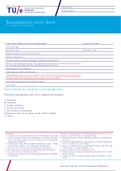Tentamen (uitwerkingen)
Exams 1BK40
7 previous exams from Business Analytics and Decision Support (1BK40) from 2015 till 2018. This course used the book Data Science for Business (ISBN: 9781449361327). The newest exam of November 2018 is included as well. The solutions are provided as well.
[Meer zien]




